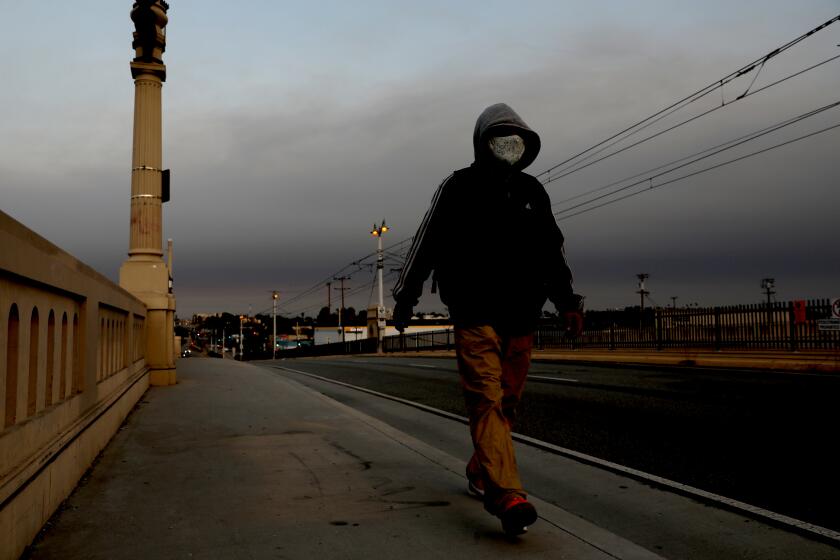DIY air filters can be safe, simple and inexpensive. Here’s how to make one
- Share via
With the reddish-orange skies and smoke-filled air, Californians who had previously never heard of PM2.5 pollution are quickly learning about the Air Quality Index and what they need to do to protect themselves from wildfire pollution.
Thomas Talhelm, founder of Smart Air, a company that sells DIY air purifiers and teaches people how to make their own, remembers being in the same position in 2013. He was living in Beijing, and the air pollution hit record highs. Hospitals were flooded with patients with respiratory problems, and he had a cough he couldn’t shake for weeks.
When he learned that the air purifier he wanted cost $1,000, he did his own research and built a DIY air purifier by securing a HEPA filter to a fan.
This article is provided free of charge to help keep our community safe and supported during these devastating fires.
That began a seven-year journey of buying laser particle counters, testing different fans and filters, and comparing his homemade built purifiers to store-bought models to prove that simple DIY air purifiers can be almost as effective as the expensive ones.
Around the same time, Reducing Outdoor Contaminants in Indoor Spaces (ROCIS), was founded in southwest Pennsylvania, where the air quality has historically been a problem.
“The premise was, if you have poor air quality and you can’t afford to or don’t want to move away, what can you do in your home, workplace and school?” explains Linda Wigington, a ROCIS team leader.
Their team, which now has over 400 people, started testing portable air purifiers, but when they heard of the DIY options made from an air filter attached to a box fan, they started making and testing the home-made ones simultaneously.
They also found it can filter out most of the harmful particulate matter.
Environmental agencies, including the Puget Sound Clean Air Agency in Seattle and the California Air Resources Board (CARB), encourage people to turn off the fans periodically to avoid overheating, and to not use them when unattended or while you sleep.
But both organizations acknowledge that overheating is rare and that their recommendations are out of an abundance of caution. Newer fans have thermal fuses that prevent them from overheating or causing fires.
Talhelm said that out of the more than 50,000 DIY purifiers his outfit has shipped, they’ve heard about fewer than five that have overheated, and in those cases, the fan just died.
Therefore, if the air is unhealthy, Talhelm and Wigington encourage using the purifiers any time you’re in the room, including while you are sleeping.
Smart Air’s data shows that if you turn off the filter, poor air quality can return in about 80 minutes.
“When I started Smart Air, in a way I was really angry at larger purifier companies, because they’re out here trying to convince people it costs $1,000 to protect your health,” Talhelm said. “Which if people believe, there are just going to be a lot of people who don’t protect their health.
“People — when they’re scared and when they don’t understand how something works, which was me, until I was confronted with having to paying $1,000 — we use price as a proxy for quality. … The only way to combat that is with data.”
Steps to build a DIY air purifier
Buy a fan (or use one you already have)
Make sure it’s a newer fan, because if it was purchased after 2012, it should have a thermal fuse that keeps it from overheating.
ROCIS and the Puget Sound Clean Air Agency recommend purchasing a 20-inch by 20-inch box fan that can be easily fitted with a filter of the same dimensions. Ideally whatever fan you use should have a flat surface, which makes it easier to mate securely to the filter. You can use a fan that is not flat, but it might be easier to get a new box fan, which cost as little as $15 to $20.
Talhelm said their data didn’t show much difference between their DIY air purifiers made with expensive fans and cheaper fans, but if you have a choice, he recommends finding one that is strong.
Buy a filter
Talhelm recommends a HEPA filter, which is what is found in many store-bought air purifiers and filters 99.97% of airborne particles with a size of 0.3 microns. The ROCIS and Puget Sound guides recommend a MERV 13 furnace filter, which catches over 90% of the same particles and may be cheaper and more accessible. Bottom line: Find the best one you can.
Secure the air filter to the fan
The Smart Air guide shows you how to pull the grating off the front of the fan and strap on the filter, and the Puget Sound tutorial shows you how to secure the filter to the fan with hardware. But you can also just use duct tape, as the ROCIS guide explains.
Smart Air and ROCIS recommend putting the filter on the front of the fan, while Puget Sound recommends the back. Smart Air’s data shows that it’s 11% more effective on the front, compared with the back, but Talhelm said it’s more important to put it on the side where the surface is flatter (many fans might have their controls in the front or back).
Also, on most filters, there will be an arrow indicating the recommended direction of the air flow, but Talhelm said if there’s no arrow or you can’t figure it out, don’t stress. Their tests show that even if you put it on backwards, it’s only slightly less effective.
Run it whenever you’re in the room
If the air outside is unhealthy, both Talhelm and Wigington recommend running the purifiers continuously or at least whenever you are present in the space. They recommend having one in the bedroom and in any areas you spend a lot of time, for example, a family room or office. But it never hurts to be cautious, on the remote chance that it overheats.
The air around Southern California feels like smoke soup because of wildfires. What does that mean for your health and daily routines?
Other tips
It’s better to use air purifiers indoors with the doors and windows closed. But Smart Air data show that they can still reduce particulate matter with the windows open. “This can be critical if it’s hot, or if we need ventilation for CO2 or coronavirus mitigation,” said Talhelm.
Keep the purifier out of the way of curtains and water.
Change the filters when they start to clog. Often it’ll be discolored or even turn black, depending on how bad the air quality is.








